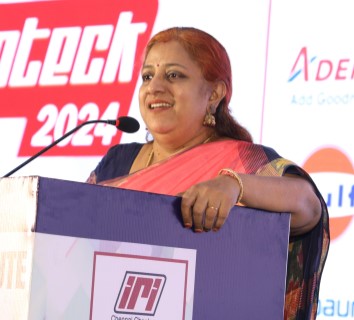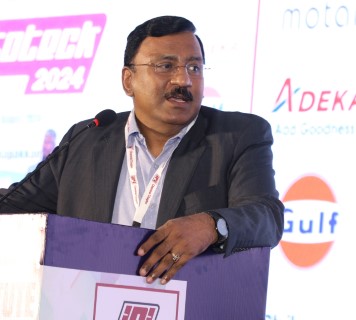 Dr. KR Sridhar received his BE Honors degree in Mechanical Engineering from NITT (RECT) in 1982. He obtained his MS and Ph.D from UniversityOf Illinois, Urbana-Champaign. He is the Principal Co-Founder and CEO of Bloom Energy – a California Based Fuel Cell Company, whose mission is to develop and commercialize products that enable electricity to be available abundantly, sustainably, reliably, and in an affordable manner globally . He earlier worked as Professor of Aerospace and Mechanical Engineering as well as Director of the renowned Space Technologies Laboratory (STL) at the University of Arizona. He led a team developing technologies to Sustain Life on Mars for NASA. He has served as an advisor to NASA on Mars missions and nanotechnology. Fortune Magazine recognized him as “One of the Top Five Futurists that are inventing tomorrow, today”. He has served on many technical committees, panels and advisory boards. He has over 50 publications.
Dr. KR Sridhar received his BE Honors degree in Mechanical Engineering from NITT (RECT) in 1982. He obtained his MS and Ph.D from UniversityOf Illinois, Urbana-Champaign. He is the Principal Co-Founder and CEO of Bloom Energy – a California Based Fuel Cell Company, whose mission is to develop and commercialize products that enable electricity to be available abundantly, sustainably, reliably, and in an affordable manner globally . He earlier worked as Professor of Aerospace and Mechanical Engineering as well as Director of the renowned Space Technologies Laboratory (STL) at the University of Arizona. He led a team developing technologies to Sustain Life on Mars for NASA. He has served as an advisor to NASA on Mars missions and nanotechnology. Fortune Magazine recognized him as “One of the Top Five Futurists that are inventing tomorrow, today”. He has served on many technical committees, panels and advisory boards. He has over 50 publications.
Global Economics
By Jennifer L. Schenker on December 07, 2009
Bloom Energy Shifts Power via Fuel Cells
Breakthrough technology from a richly funded Silicon Valley startup could revolutionize the energy business, especially in the developing world Around 1.5 billion people, or nearly a quarter of the world’s population, live without electricity today. That’s according to figures from a November U.N. report centering on the plight of people in places like South Asia and sub-Saharan Africa who lack access to modern energy.
Many of these “powerless” live as humans did centuries ago, in darkness and cooking over wood fires that damage their health and the environment. To halve the proportion of people living in poverty by 2015—one of the U.N.’s eight Millennium Development Goals—1.2 billion more people must gain access to electricity and 2 billion more need to obtain other fuels such as natural gas or propane, according to the U.N. But building traditional power grids would take too long, cost too much, and only add to the world’s climate change woes.
Enter Bloom Energy, one of 26 companies named on Dec. 3 by the World Economic Forum as 2010 Tech Pioneers offering new technologies or business models that could advance the global economy and have a positive impact on people’s lives. Through its cutting-edge work with fuel cell technology, the Sunnyvale (Calif.) company aims to help homes and businesses generate their own electricity and fuel their own vehicles—bringing power and light to remote villages and even reducing dependence on today’s electricity grids in the developed world. The technology at the heart of Bloom Energy’s vision to help planet earth was first developed for use in outer space. While working as a director of the Space Technologies Laboratory at the University of Arizona, the company’s Indian-born co-founder and chief executive, K.R. Sridhar, was asked by NASA to come up with a way to make life sustainable on Mars. His lab’s initial project was a device that would use solar power and Martian water to drive a reactor cell that generated oxygen to breathe and hydrogen to power vehicles.
The Bloom Box
The project set Sridhar thinking. If he reversed the reaction—feeding oxygen and fuel (hydrogen) into the cell to generate electricity—he could change the way people generated and consumed energy. He developed the first of his so-called Bloom boxes to do just that, but took it a step further by making the process reversible. That way, when hooked up to a renewable power source such as a wind turbine or solar panel, the refrigerator-size unit makes and stores hydrogen and oxygen. And at night or when the wind dies down, it changes direction and uses the stored gases to make electricity. “I quit doing my NASA work because I believe this particular technology can change the world,” says Sridhar. “Just like developing nations leapfrogged over fixed telephony to mobile, we think our technology will allow developing nations to do the same thing for electricity.” The Bloom box also has another benefit that could become increasingly important if the world’s automakers succeed at developing hydrogen-powered vehicles. Since one of the byproducts of the Bloom fuel cell is hydrogen, the device could be used to create fuel for cars. And even if hydrogen vehicles don’t materialize for decades, Bloom boxes could generate electricity for hybrid or electric cars. Either way, the system would allow people to sidestep traditional gas stations. With his ideas in hand, Sridhar approached venture capitalists Kleiner, Perkins, Caulfield & Byers, and the venerable Silicon Valley firm responded by making its first-ever cleantech investment. Precise funding figures aren’t public, but Bloom Energy says it has raised “hundreds of millions” of dollars in financing. The company’s valuation has been pegged in press reports at more than $1 billion.
Fuel Cell Trials
From the start, the eight-year-old company has been shrouded in secrecy, and its executives remain tight-lipped. But some details are slowly leaking out. Stu Aaron, Bloom Energy’s vice-president for marketing and product management, confirms press reports about a University of Tennessee trial in which a Bloom box capable of powering a 5,000-square-foot home proved twice as efficient as a traditional gas-burning system and produced 60% fewer emissions. The company won’t comment on reports that the city of San Jose recently granted online auction giant eBay (EBAY) permission to install five fuel cells from Bloom Energy that will generate up to 500 kilowatts of power, nor that search giant Google (GOOG) is separately testing the system. But Bloom Energy does confirm it’s aiming its initial systems at business customers that want to explore whether they can get reliable green energy at the same price or less than they now pay the electric company. Why all the secrecy? To date, fuel cells have underdelivered on their promise, says Aaron, so Bloom Energy wants to wait until it has solid field experience with real customers to tell its full story. What is known is that the company’s fuel cell technology is different from hydrogen fuel cells, which have been around for decades. For starters, Bloom’s system relies primarily on oxygen rather than hydrogen. And instead of requiring expensive precious metals, the fuel cell is built from a cheap ceramic material, sand. That should allow it to be more easily mass-produced, helping cut costs and widen its potential market.
New Industry
The ceramic core acts as an electrode. At high temperatures, a hydrocarbon fuel—ethanol, biodiesel, methane, or natural gas—on one side of the cell attracts oxygen ions from the other. As the ions are pulled through the solid core, the resulting electrochemical reaction creates electricity. Though the technology consumes hydrocarbons, Sridhar says, it doesn’t involve carbon-releasing combustion, so it emits only about half the greenhouse gases of conventional energy sources. If the technology works as envisioned on a commercial scale, Bloom boxes could help cut carbon emissions and energy costs in the developed world, where they’re likely to be used as a complement to, rather than a replacement of, traditional power grids. But the biggest impact will be in villages throughout the developing world that are now cut off from power supplies. “Access to electricity is a life-enhancer,” Sridhar says. “It means access to information, access to education, to clean water, and to good health because refrigeration will prevent food from spoiling.” Sridhar figures it will take three to five years before Bloom boxes reach “grid parity” for home use, or price competitiveness with traditional residential-scale electric supplies. Replacing gas stations is expected to take longer, and depends on the emergence of new vehicles. “We are really building an industry, not a company,” says Sridhar. “We need an entire supply chain around us to scale.” Then again, the company is based in Silicon Valley, where people know how to do that. The flat sand electrodes used in Bloom boxes, for instance, could be manufactured using some of the same processes now used by the Valley’s chipmakers. Synergies like that are what lead Bloom Energy executives to hope they can someday create an equally important new industry that will help power the world in whole new ways.
NRI readies power plant in a box
Chidanand Rajghatta, TNN Feb 23, 2010, 01.04am IST
WASHINGTON: The world of energy and entrepreneurship is crackling with electric anticipation this week after an India-born scientist-CEO provided a sneak peek over the weekend at a clean and efficient model of power generation-in-a-box that could eliminate the traditional grid and challenge monopolies.
Supporters are claiming K.R.Sridhar’s ”Bloom box,” scheduled for a big-splash unveiling in Silivon Valley on Wednesday, could be the Holy Grail of the world’s energy quest; and even skeptics agree that it is a unique ”power-plant-in-a-box.” What acres of power grid can generate, Sridhar’s Bloom Box can crank out in a fraction of the footprint — in a squeaky clean manner too.
It is already being done — on the campuses of Google and eBay among others. FedEx, Wal-Mart and Staples are among a score of Fortune 100 companies that have signed up as clients. Former Secretary of State Colin Powell, among those who endorse the technology, is on the Board of Directors of Sridhar’s Bloom Energy, an eight-year old stealth start-up that raised more than $ 400 million from Silicon Valley’s venture capitalists at a time the region’s economy was in a tail-spin.
At its heart, Sridhar’s Bloom Box claims to be a game-changing fuel cell device that consists of a stack of ceramic disks coated with secret green and black “inks.” The disks are separated by cheap metal plates. Stacking the ceramic disks into a bread loaf-sized unit, says Sridhar, can produce one kilowatt of electricity, enough to power an American home – or four Indian homes.
The unit can be scaled up, installed anywhere, and be connected to an electrical grid just like you would connect your PC to the Internet. Hydrocarbons such as natural gas or biofuel (stored separately) are pumped into the Bloom Box to produce clean, scaled-up, and reliable electricity. The company says the unit does not vibrate, emits no sound, and has no smell, although Sridhar admits to some initial, but minor, glitches at some installations.
A hoax it is not, although some are suggesting there is a lot of hype around the launch — somewhat like with that of the Segway transporter that was much bally-hooed but did not live up to its billing. As with Segway, the big catch right now is cost. Large-sized Bloom Boxes of the kind installed at some Silicon Valley campuses costs around $ 700,000 to $ 800,000. Sridhar estimates that a Bloom Box for the residential market could be out within a decade for as little as $3,000 to produce electricity 24/7/365. “In five to ten years, we would like to be in every home,” Sridhar told CBS’ “60 Minutes” on Sunday night.
But Silicon Valley, whose major venture capitalist Kleiner Perkins’ bankrolled Bloom Energy, is endorsing the technology. EBay said it has already saved $100,000 in electricity costs since its 5 boxes were installed nine months ago. It even claims that the Bloom boxes generate more power than the 3,000 solar panels at its headquarters. Google has a 400 kilowatt installation from Bloom at its Mountain View headquarters. California’s governor Arnold Schwarzeneggerwill be at the launch, which is to take place on the eBay campus.
The man at the center of all the excitement is Dr K.R. Sridhar, 49, who, prior to founding Bloom Energy, was a professor of Aerospace and Mechanical Engineering as well as Director of the Space Technologies Laboratory (STL) at the University of Arizona. He is also, literally, a rocket scientist, having served as an advisor to NASA in the areas of nanotechnology and planetary missions. Sridhar initially developed the idea behind the Bloom Box while working with NASA, as a means of producing oxygen for astronauts landing on Mars.
Dr. Sridhar received his Bachelors Degree in Mechanical Engineering from the University of Madras, India, and moved to in the 1980s to the U.S, where he earned an M.S. in Nuclear Engineering and Ph.D. in Mechanical Engineering from the University of Illinois, Urbana-Champaign, home to such start ups as Netscape. On Sunday, CBS’ 60 Minutes homed in on Sridhar’s breakthrough technology, bringing huge attention to Bloom Energy’s bare-bones website that ran a cryptic visual saying ”Be the Solution” — and a clock counting down to Wednesday’s launch.




